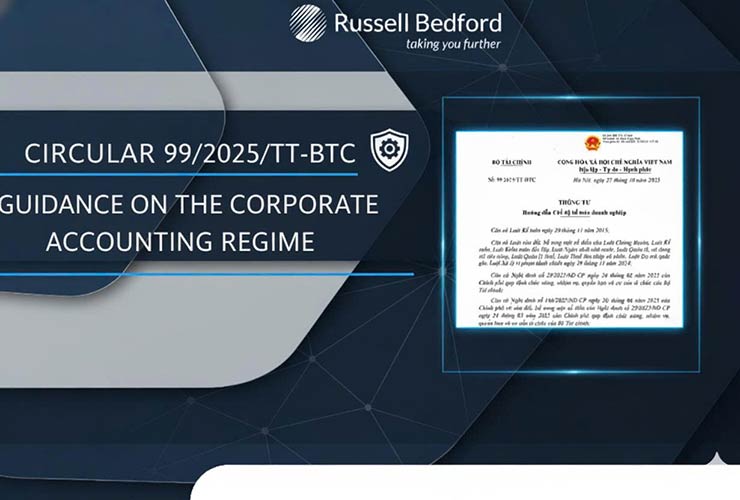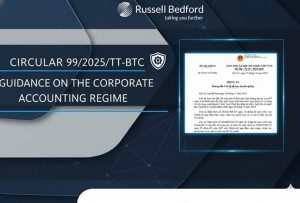(replacing Circular 200/2014/TT-BTC)
On 27 October 2025, the Ministry of Finance issued Circular 99/2025/TT-BTC (“Circular 99”) on the corporate accounting regime, replacing Circular 200/2014/TT-BTC (“Circular 200”) dated 22 December 2014.
Circular 99 will take effect from 1 January 2026, and applies to financial years starting on or after 1 January 2026.
Russell Bedford KTC has summarized the key points of Circular 99 that business owners, management, accountants, and auditors should pay particular attention to:
1. Addition of Regulations on Corporate Governance and Internal Controls in Accounting
While Circular 200 primarily focused on guidance for bookkeeping and financial reporting, Circular 99 expands its scope to include internal governance, internal control, and accounting autonomy mechanisms within enterprises.
According to Clause 2, Article 3 of Circular 99, enterprises are required to establish internal governance regulations (or equivalent documentation) and implement internal control systems to clearly define the roles and responsibilities of each department and individual in the process of initiating, executing, and monitoring economic transactions.
This provision is introduced for the first time in the corporate accounting framework, marking a significant shift toward a modern managerial accounting model that emphasizes risk control and financial management within enterprises.
2. Principles for Preparing Financial Statements When Changing Accounting Currency
(Based on Clause 2, Article 5 of Circular 99/2025/TT-BTC)
When changing the accounting currency, enterprises must adhere to the following principles:
- Opening balance conversion: Accounting entries and the statement of financial position must be converted to the new currency at the average interbank exchange rate of the commercial bank where the business regularly transacts at the time of change.
- Comparative information: Prior period figures in the profit and loss statement and cash flow statement should be converted using the average exchange rate of the immediately preceding period.
- Notes to the financial statements: Enterprises must disclose the reasons for changing the accounting currency and explain the effects of such change on the financial statements.
This provision aims to enhance the transparency and comparability of financial information in cases where the accounting currency is changed.
3. Regulations on Enterprises Using a Foreign Currency as Accounting Currency
(Based on Clauses 1 and 2, Article 6, Circular No. 99/2025/TT-BTC)
- Financial statements that are published or submitted to state authorities must be presented in Vietnamese Dong (VND). If an enterprise uses a foreign currency as its accounting currency, it must convert the financial statements into VND in accordance with the guidance provided in Clause 3, Article 6.
- If the enterprise is required to undergo an independent audit, the audited financial statements must be those presented in Vietnamese Dong.
Accordingly, although enterprises are permitted to use a foreign currency for accounting purposes, the legally recognized reporting currency remains VND, ensuring consistency and alignment with the national financial system.
4. Simplification of Accounting for Subsidiaries
(Based on Article 7 of Circular 99/2025/TT-BTC)
Circular 99 introduces clearer and more flexible regulations regarding the organization of accounting departments, particularly the relationship between the parent company, branches, and subsidiaries, aiming to facilitate financial management and consolidated reporting.
- Subsidiaries may choose to record capital contributed by the parent company as either liabilities or equity, depending on their management model.
- Businesses may choose whether to recognize revenue and cost of goods sold for internal transfers, regardless of whether an invoice is issued.
- Companies may decide whether to prepare separate financial statements for subsidiaries, as long as the final consolidated financial statements fully reflect the enterprise’s overall financial position.
These provisions allow businesses to customize the recognition of capital, internal revenue, and subsidiary reporting, while ensuring accurate and complete consolidated statements, enhancing management efficiency and transparency across the accounting system.
5. Updates on Accounting Documents
(Based on Clause 2, Articles 9 and 10 of Circular 99/2025/TT-BTC)
Circular 99 empowers businesses with greater autonomy in managing accounting documents:
- Self-design of forms: Enterprises can create, supplement, or adjust accounting document templates to suit their operational characteristics, provided that they remain accurate, transparent, and verifiable in compliance with the Accounting Law.
- Simplified signature requirements: Preparation and signing of accounting documents follow the Accounting Law and relevant guidelines, without detailed specifications for signature format, ink type, or writing method as previously required.
Compared to Circular 200, these new provisions provide greater flexibility for transitioning to electronic accounting systems and reduce reliance on traditional paper forms.
6. Changes in Accounting Chart and Account System
(Based on Article 11 of Circular 99/2025/TT-BTC)
- Businesses must adopt the new chart of accounts provided in Appendix II of Circular 99.
- Enterprises are permitted to modify or supplement account names, codes, structure, and reporting content to reflect their specific management needs, as long as the basic legal requirements are met.
This represents a significant shift from a “permission–approval” model to a “self-governance–accountability” approach, encouraging greater flexibility in accounting management.
7. Updates on Financial Statements under the New Standards
Circular 99 specifies four basic financial statements:
- Statement of Financial Position (replacing the “Balance Sheet”)
- Profit and Loss Statement
- Cash Flow Statement
- Notes to the Financial Statements
For businesses that do not meet the going concern assumption (e.g., dissolution, bankruptcy, or cessation of operations), four separate templates are provided.
The Ministry of Finance also requires expanded disclosures, including:
- Basis for determining the currency used;
- Effects of exchange rate changes;
- Scope of consolidation and intra-group transactions;
- Financial risks (currency, interest rate, credit).
For consolidated statements, companies with branches must consolidate all subsidiaries and eliminate internal transactions, rather than preparing separate summary statements as before.
Circular 99 also allows flexible presentation, such as omitting non-material line items or rearranging lines without changing their codes.
8. Other Notable Provisions
- Revenue recognition: Emphasizes compliance with the performance obligation principle.
- Promotional goods: For promotional items, accounting is recorded as Debit (Expense) / Credit 3331 (VAT payable), consistent with Circular 133.
- Inventory cost calculation: Businesses may apply different methods for different materials or goods, rather than a single method for all inventory.
- Standard Cost Method: Circular 99 provides guidance on using standard costing for production cost calculation, enabling immediate cost assessment and faster profit/loss calculation. Differences between standard and actual costs are adjusted in cost of goods sold or inventory.
Below is a detailed comparison of the Accounting Chart of Accounts under Circular 99 and Circular 200
| Account No. | Circular 200 | Circular 99 | Changes |
| 112 | Cash in banks | Demand Deposits | Account renamed |
| 138 | Other Receivables 1381 – Shortage of assets awaiting resolution 1385 – Receivables from equitization 1388 – Other receivables | Other Receivables 1381 – Assets pending resolution 1383 – Excise tax on imported goods 1388 – Other receivables | Sub-account 1385 removed; 1383 added (Excise tax on imported goods) |
| 155 | Finished Goods 1551 – Finished products – inventory 1557 – Finished products – real estates | Products | Account renamed; sub-accounts removed |
| 158 | Goods in bonded warehouse | Raw materials and supplies in bonded warehouse | Account renamed |
| 215 | Not available | Biological Assets 2151 – Animals producing periodically 21511 – Immature animals 21512 – Mature animals 215121 – Original cost 215122 – Accumulated depreciation 2152 – Animals producing once 2153 – Seasonal or one-time crops | New account and sub-accounts added |
| 242 | Prepaid Expenses | Deferred Expenses | Account renamed |
| 244 | Mortgage, collaterals and deposits | Deposits and Guarantees | Account renamed |
| 332 | Not available | Dividends and Profits Payable | New account added |
| 417 | Enterprise reorganization assistance fund | Not available | Account removed |
| 419 | Treasury Shares | Not available | Account renamed |
| 441 | Capital expenditure funds | Not available | Removed |
| 461 | Non-business funds | Not available | Removed |
| 466 | Non-business funds used for fixed asset acquisitions | Not available | Removed |
| 611 | Purchases | Not available | Removed |
| 631 | Production Cost | Not available | Removed |




















